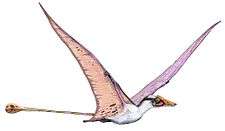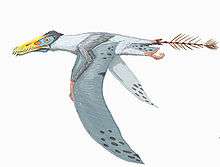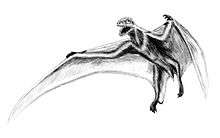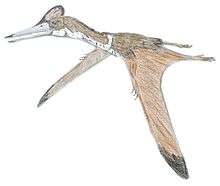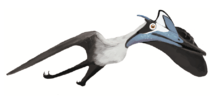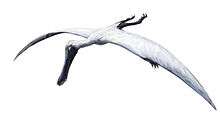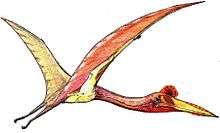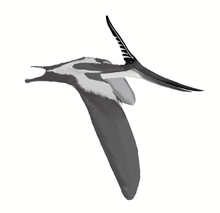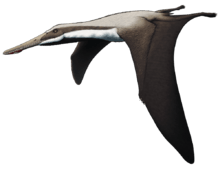Thalassodromidae
Thalassodromidae or Thalassodrominae (meaning "sea runners", due to previous misconceptions of skimming behavior; they are now thought to be terrestrial predators) is a group of azhdarchoid pterosaurs from the early Cretaceous period of Brazil. They are considered either to be a distinct family within the clade Neoazdarchia, closely related to dsungaripterids or azhdarchids, or alternatively a subfamily within the family Tapejaridae.
| Thalassodromids | |
|---|---|
 | |
| Replica skeleton of Tupuxuara leonardii | |
| Scientific classification | |
| Kingdom: | Animalia |
| Phylum: | Chordata |
| Order: | †Pterosauria |
| Suborder: | †Pterodactyloidea |
| Clade: | †Neoazhdarchia |
| Family: | †Thalassodromidae Kellner, 2007 |
| Type species | |
| †Thalassodromeus sethi Kellner & Campos, 2002 | |
| Genera | |
| Synonyms | |
| |
Classification
Thalassodromidae traditionally includes only two genera, Thalassodromeus and Tupuxuara, and was defined to include them and any other descendants of their most recent common ancestor.[1] The classification of thalassodromids is controversial. Some studies, including one by Lü and colleagues in 2008, have found that the thalassodromids are more closely related to the azhdarchids than to the tapejarids,[2] and have placed them in their own family (which has sometimes been referred to as Tupuxuaridae,[3] though Thalassodrominae was named first[1]). Alternately, they have been considered a subfamily (Thalassodrominae) within the Tapejaridae.[4]
Below are three alternate cladograms resulting from studies of azhdarchoid relationships. The first, presented by Felipe Pinheiro and colleagues in 2011, found the thalassodromids as subgroup within the Tapejaridae. The second, presented by Lü and colleagues in 2008, found them to be closer to the Azhdarchidae. The third, presented by Brian Andres, James Clark and Xu Xing in 2014, also found thalassodromids closer to azhdarchids, and as the sister group of the dsungaripterids.[5]
| Azhdarchoidea |
| ||||||||||||||||||
| Azhdarchoidea |
| ||||||||||||||||||
| Azhdarchoidea |
| ||||||||||||||||||||||||
More recently, the Late Cretaceous genera Alanqa and Aerotitan, typically considered azhdarchids, have been recovered as thalassodromids, though their remains are fragmentary enough that this judgement is only tentative.[6]
References
- Kellner, A.W.A.; Campos, D.A. (2007). "Short note on the ingroup relationships of the Tapejaridae (Pterosauria, Pterodactyloidea". Boletim do Museu Nacional. 75: 1–14.
- Lü, J., Unwin, D.M., Xu, L., and Zhang, X. (2008). "A new azhdarchoid pterosaur from the Lower Cretaceous of China and its implications for pterosaur phylogeny and evolution." Naturwissenschaften,
- Martill, D.M., Bechly, G., and Heads, S.W. (2007). "Appendix: species list for the Crato Formation." In: Martill, D.M., Bechly, G., and Loveridge, R.F. (eds.), 2007. The Crato Fossil Beds of Brazil: Window into an Ancient World. Cambridge University Press, Cambridge. Pp. 582–607.
- Pinheiro, F.L., Fortier, D.C., Schultz, C.L., De Andrade, J.A.F.G. and Bantim, R.A.M. (in press). "New information on Tupandactylus imperator, with comments on the relationships of Tapejaridae (Pterosauria)." Acta Palaeontologica Polonica, in press, available online 03 Jan 2011. doi:10.4202/app.2010.0057
- Andres, B.; Clark, J.; Xu, X. (2014). "The Earliest Pterodactyloid and the Origin of the Group". Current Biology. 24: 1011–6. doi:10.1016/j.cub.2014.03.030. PMID 24768054.
- Longrich, N.R., Martill, D.M., and Andres, B. (2018). Late Maastrichtian pterosaurs from North Africa and mass extinction of Pterosauria at the Cretaceous-Paleogene boundary. PLoS Biology, 16(3): e2001663. doi:10.1371/journal.pbio.2001663
